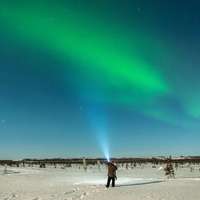
A cultural guide to Stockholm
By Justin Quirk
December 2023
Island hop in Sweden’s cool capital, where elegant architecture rubs shoulders with ultra-modern galleries and an unrivaled food scene
Your essential guide to the best things to see and do in Stockholm. Find more travel inspiration for more amazing cities here.
Built over 14 interconnecting islands, Stockholm is Sweden’s capital city and the archetypal Scandinavian destination: snow-covered winters and long bright summers, a minimalist, modern design aesthetic paired with ancient buildings and heritage, progressive social attitudes alongside an unusually high quality of life.
Like many of its neighbors, the city transformed radically in modern times with the arrival of technology and industrialization, but traces of its ancient history remain. Stockholm isn’t huge, but it does sprawl, so pace yourself and don’t try to cover everything in one weekend—it’s a place you’ll want to return to again and again.

Stop off in the hipster area of Södermalm
Art & architecture
Sweden’s cultural heritage is proudly on show from the moment you arrive, with the entrance halls at Arlanda airport lined with portraits of writers, illustrators, chefs and designers as part of the Welcome to My Hometown installation. The city is rich in galleries: Orient yourself with the big hitters at Moderna Museet (look for the giant Alexander Calder sculptures outside), Fotografiska (one of the world’s most important photographic collections), and Kulturhuset Stadsteatern.
The ABBA museum is an immersive pop spectacular, while the recently opened Accelerator looks at the collision of science and art (check seasonal opening times). For those exploring more deeply, independent galleries CF Hill and Galerie Nordenhake are both highly respected.
Expert tips
The essentials
Stockholm has four international airports close to the city center. Arlanda Airport (ARN) is the only airport for transcontinental flights. The Arlanda express train leaves every 15 minutes to Stockholm Central Station and takes 23 minutes. From there, travel by tram, metro, or bus. Flygbussarna Airport Coaches depart every 10 to 15 minutes and take around 45 minutes to get to the city center. Taxis and rideshares take the same amount of time. Swedish is the local language, and Swedes are renowned for their excellent English. Nevertheless, saying “tack” for “thank you” and “hej” for “hello” will be well received.
Getting around
The Stockholm Metro or “T-Bana” is the most efficient way to get around the city, with more than 100 stations in and around the center. Pay for any Stockholm public transportation system with SL card, app, or contactless card. The Metro system features 14 stations with notable art installations and exhibitions with their own themes. For an alternative view of the city, travel between Stockholm’s islands by boat. Many depart from Nybroviken in the center.
Accessibility
Sweden ensures accessibility in most public spaces and Stockholm ranks among the world’s best cities for accessibility and mobility. Buses, metro stations and ferries are accessible, including ramps to bridge the metro platform and train gap. Street crossings have audio indications, while low curbs and smooth pavements are typical, although Gamla Stan has cobbled streets. The Moderna Museet of modern and contemporary art offers tactile tours for visually impaired visitors, as well as signed tours. Its major exhibitions are also free to all.
LGBTQ+
Stockholm is a largely LGBTQ+ friendly city. Popular LGBTQ+ areas include Södermalm district and Gamla Stan. Stockholm Pride takes place at Östermalms IP (also known as Pride Park) during late July or early August, and features music performances throughout the week.
Christmas markets
As you’d expect from a beautiful Scandinavian city, Christmas is a big deal in Stockholm with several specific markets taking place over the festive period. Stortorget Market is the oldest and most traditional, dating back to 1837 and situated in Gamla Stan (old town). The Skansen market takes place in the grounds of the Skansen open air museum. There’s also a Christmas fair that takes place at the Royal Stables, usually for just one weekend. Dates for all markets can move each year, so confirm before booking.

Cinnamon buns are a staple of the Swedish coffee break
Food & drink
Voted the European Capital of Gastronomy 2023, Stockholm offers plentiful examples of the New Nordic style in restaurants. For classic Swedish dishes and rooftop views of the city, Freyja is recommended, while those in search of a unique dining experience are pointed towards Brutalisten, the brainchild of experimental artist Carsten Höller.
But it’s in fusions with other cuisines where Stockholm really excels: Currently hot are the Jewish-inflected Schmaltz, the Mediterranean flavors at Hotel Villa Dagmar’s courtyard restaurant, and the disco-fied Japanese experience at Misshumasshu (start with the coriander-rich avocado “Guacamasshu”). If it’s a (very) special occasion, push the boat out at Michelin-starred Ekstedt. For wine lovers, Bar Ninja in the Södermalm district is unbeatable.
Music
Sweden’s biggest cultural export in recent years has been the stadium-filling house of Avicii and Swedish House Mafia, and there’s plenty of that kind of thing on offer at vast multi-level clubs like Sturecompagniet. For a more intimate experience, try “listening bar” Hosoi, with an audiophile soundsystem in its 350-capacity room along with a wine bar (there’s also a spin-off Hosoi festival planned).
To maximize the longer days, Trädgården is an outdoor club located under the Skanstullsbron bridge, with live acts and DJs during the summer months. A good starting point for musical exploration is the hipster area of Södermalm: Orient yourself around the main thoroughfare, Hornsgatan, where it meets the square at Mariatorget, and follow your ears.

The northern lights: Now’s the time
Why your chances of seeing the aurora are higher than ever
Watch before you go
For historical views of Stockholm, several classics will show you the city as it was: Thrilling police drama The Man on the Roof (1976) reaches its explosive climax in Vasastan, while Bergman fanatics will find the locations for The Seventh Seal and Wild Strawberries (both 1957), among others, close by. Both the Swedish original and American remake of The Girl with the Dragon Tattoo (2011) were filmed in Stockholm, while early Studio Ghibli animation Kiki’s Delivery Service (1989) conjures up a fantasy version of the Swedish capital. And vampire fans will recognize the streets of the Blackeberg suburb from 2008’s Let the Right One In.
For a first-time visitor, Norrmalm offers the best jump-off point for the Swedish capital. Facing south onto the expansive waterfront and just north of the buzzing public square at Kungsträdgården, this is where you’ll find Stockholm Central Station, the shops and department stores around Sergels Square and the cultural centers of the Kulturhuset and the Royal Dramatic Theatre. It’s also a short walk south onto the island of Gamla Stan, where you’ll find the old town’s maze of winding streets and brightly colored houses.
This is Stockholm’s upscale district. The main road bordering it to the west (Birger Jarlsgatan) is lined with luxury boutiques, while the streets to the east of Humlegården park are a design lover’s delight. Explore mid-century modern furniture at The Modern Sthlm, Nordiska Galleriet and Modernity. For streetwear, the Junkyard Skate Shop, Our Legacy and Nudie Jeans‘ flagship store are close by, while anyone looking for vintage Danish interiors will lose hours in the Re: Deco second-hand store.
Enjoy the scent of the plentiful summer flowers at Olas Blommor, then recover with fika (coffee and cake) at the hidden-away Stora café, or an uncommonly flavored gelato at Triple Oh! (fresh lemon and rapeseed oil was selling out fast on our visit).
This trendy area sits to the south of Stockholm’s main island. Originally dock buildings and farmland, it has gained a reputation as a relaxed, creative district, just 10 minutes from Stockholm Central Station. The steeply sloped streets offer a wealth of gallery offerings, including the street art collection at Gallery Steinsland Berliner.
Walk the length of Hornsgatan Street across the north of Södermalm, taking a detour a few blocks south to recharge at local institution Drop Coffee. Finish by Slussen station for the perfect view across Stockholm and the water.

Justin Quirk is Associate Creative Director of Editorial at Expedia Group, as well as a writer and editor who has worked for titles including The Sunday Times, The Guardian and Esquire covering music, design, and current affairs. He is also the author of Nothin’ But a Good Time, an acclaimed cultural history of 1980s heavy metal.
Hotel deals in Stockholm






